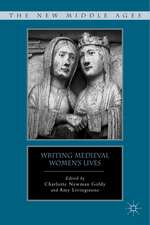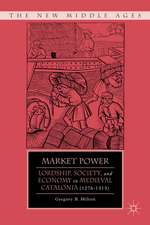Living with Disfigurement in Early Medieval Europe
Autor Patricia Skinneren Limba Engleză Paperback – 21 feb 2020
This book examines social and medical responses to the disfigured face in early medieval Europe, arguing that the study of head and facial injuries can offer a new contribution to the history of early medieval medicine and culture, as well as exploring the language of violence and social interactions. Despite the prevalence of warfare and conflict in early medieval society, and a veritable industry of medieval historians studying it, there has in fact been very little attention paid to the subject of head wounds and facial damage in the course of war and/or punitive justice. The impact of acquired disfigurement —for the individual, and for her or his family and community—is barely registered, and only recently has there been any attempt to explore the question of how damaged tissue and bone might be treated medically or surgically. In the wake of new work on disability and the emotions in the medieval period, this study documents how acquired disfigurement is recorded across different geographical and chronological contexts in the period.
| Toate formatele și edițiile | Preț | Express |
|---|---|---|
| Paperback (1) | 167.76 lei 6-8 săpt. | |
| Palgrave Macmillan US – 21 feb 2020 | 167.76 lei 6-8 săpt. | |
| Hardback (1) | 226.07 lei 6-8 săpt. | |
| Palgrave Macmillan US – 21 dec 2016 | 226.07 lei 6-8 săpt. |
Preț: 167.76 lei
Nou
Puncte Express: 252
Preț estimativ în valută:
32.11€ • 33.43$ • 27.13£
32.11€ • 33.43$ • 27.13£
Carte tipărită la comandă
Livrare economică 10-24 martie
Preluare comenzi: 021 569.72.76
Specificații
ISBN-13: 9781349959860
ISBN-10: 1349959863
Ilustrații: X, 282 p.
Dimensiuni: 148 x 210 mm
Greutate: 0.35 kg
Ediția:1st ed. 2017
Editura: Palgrave Macmillan US
Colecția Palgrave Macmillan
Locul publicării:New York, United States
ISBN-10: 1349959863
Ilustrații: X, 282 p.
Dimensiuni: 148 x 210 mm
Greutate: 0.35 kg
Ediția:1st ed. 2017
Editura: Palgrave Macmillan US
Colecția Palgrave Macmillan
Locul publicării:New York, United States
Cuprins
Contents
Acknowledgments
1. Introduction: Writing and Reading about Medieval Disfigurement
2. The Face, Honor and 'Face'
3. Disfigurement, Authority and the Law 4. Stigma and Disfigurement: Putting on a Brave Face?
5. Defacing Women: the Gendering of Disfigurement
6. Ways of Seeing: Staring at and Representing Disfigurement
7. Paths to Rehabilitation? The Possibilities of Treatment 8. Conclusion
Appendix I
Appendix II
Bibliography
Index
Acknowledgments
1. Introduction: Writing and Reading about Medieval Disfigurement
2. The Face, Honor and 'Face'
3. Disfigurement, Authority and the Law 4. Stigma and Disfigurement: Putting on a Brave Face?
5. Defacing Women: the Gendering of Disfigurement
6. Ways of Seeing: Staring at and Representing Disfigurement
7. Paths to Rehabilitation? The Possibilities of Treatment 8. Conclusion
Appendix I
Appendix II
Bibliography
Index
Notă biografică
Patricia Skinner is Research Professor in Arts and Humanities at Swansea University, UK. She is the Director of the Effaced from History project, sponsored by the Wellcome Trust, and has previously published books on gender, medicine, and health, in addition to the social history of southern Italy.
Textul de pe ultima copertă
This book is open access under a CC-BY 4.0 license.
This book examines social and medical responses to the disfigured face in early medieval Europe, arguing that the study of head and facial injuries can offer a new contribution to the history of early medieval medicine and culture, as well as exploring the language of violence and social interactions. Despite the prevalence of warfare and conflict in early medieval society, and a veritable industry of medieval historians studying it, there has in fact been very little attention paid to the subject of head wounds and facial damage in the course of war and/or punitive justice. The impact of acquired disfigurement —for the individual, and for her or his family and community—is barely registered, and only recently has there been any attempt to explore the question of how damaged tissue and bone might be treated medically or surgically. In the wake of new work on disability and the emotions in the medieval period, this study documents how acquired disfigurement is recorded across different geographical and chronological contexts in the period.
This book examines social and medical responses to the disfigured face in early medieval Europe, arguing that the study of head and facial injuries can offer a new contribution to the history of early medieval medicine and culture, as well as exploring the language of violence and social interactions. Despite the prevalence of warfare and conflict in early medieval society, and a veritable industry of medieval historians studying it, there has in fact been very little attention paid to the subject of head wounds and facial damage in the course of war and/or punitive justice. The impact of acquired disfigurement —for the individual, and for her or his family and community—is barely registered, and only recently has there been any attempt to explore the question of how damaged tissue and bone might be treated medically or surgically. In the wake of new work on disability and the emotions in the medieval period, this study documents how acquired disfigurement is recorded across different geographical and chronological contexts in the period.
Caracteristici
Explores a vastly overlooked area of study within medieval studies
Incorporates cutting-edge work within disability studies and the history of emotions
Covers a wide expanse of time and different geographical contexts within the period
Incorporates cutting-edge work within disability studies and the history of emotions
Covers a wide expanse of time and different geographical contexts within the period


















